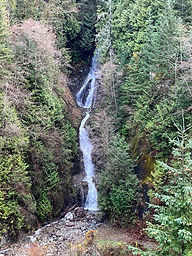Gardening After Solstice
- kc dyer

- Jun 23
- 4 min read
Summer growing season ideal for local pollinators

Summer solstice was on Friday, and with recent rains, thumbs are glowing green all over the Village. Resident garden aficionados (and Butterflyway Rangers) Val Morton and Hana Boye have a few tips to share for local gardeners now that summer is officially here.
For those who worry that it's too late to plant, Morton offers some reassurance. "It's fine to plant at this time of year as long as you are able to keep the new plants watered until they settle in and establish their roots. Even though it has not been extremely hot lately, we can anticipate a heat wave at any time, so just be prepared to keep the watering going if necessary."
When planting seedlings, however, Morton says that careful attention is warranted, with each type of seed having its own requirements for sowing and weather. She notes that many indigenous plant seeds need special treatment as they are adapted to germinating after experiencing a cold and wet period.
"This is called wet cold stratification and it signals to the seed that winter has come and gone and it is safe to germinate," she says. "We often have seed-sharing workshops in the fall where we discuss conditions required by various indigenous plants, but they all differ somewhat."
Boye notes that a wide variety of indigenous plants are on offer for gardeners on the lookout for local varieties. "It's good to keep in mind that many indigenous plants are somewhat inconspicuous, and often not as showy as the various cultivars and hybrids that are available in the nurseries," she advises.
In fact, many local plants have long been considered weeds. "The goldenrod is visited by many indigenous flies and bees and provides excellent ‘ecosystem services’, and yet it is not one that we might think about putting in our gardens," she says.
These local gardeners note that choosing indigenous plants often requires a different mindset. "We all tend to be tempted by the vibrant beauties that might not be as beneficial to the ecosystem," says Morton. "One indigenous plant that we love is the nodding onion. It is just getting ready to bloom, it really attracts the bees, and yet one would hardly notice it."
Coastal penstemon (beard tongue) is also a favourite with pollinators and is currently in bloom. Morton says that many of the nursery varieties of beard tongue are also attractive to local pollinators. These plants thrive in full sun and are easy to grow.
The garden ladies note that it is helpful to choose plants that provide a source of nectar and pollen throughout the growing season. "If you are thinking ahead to the late summer and fall, a good choice to plant right now is the aster," says Boye. "Asters attract multitudes of insects later in the summer. The native Douglas aster is a very beneficial for pollinators and it has a fairly long bloom period."
If you are looking to add a tree to your garden, Morton suggests planting in early spring or later in the fall to minimize shock and give the tree the best chance of survival.
Again, the temperature of the soil and the availability of water are critical factors in determining when to plant small trees. (You can read more about planting trees HERE).
As we move into the dry season, the garden ladies recommend using mulch around plants to help reduce evaporation and retain soil moisture. Fallen leaves from last year make ideal mulch the following spring.
"Another strategy to avoid evaporation is to water during the cooler parts of the day, in the morning or evening. This allows the water to soak into the soil before the soil warms up in the sun," says Boye.
She notes that drip lines and soaker hoses can help conserve water as they deliver the water to the roots of the plant, where it is most needed. And of course collecting rain water in a rain barrel can also assist in keeping your plants alive during dry spells and when there are watering restrictions.
Morton and Boye are vocal about their campaign to help reduce invasive plants in Lions Bay. They note that plants including ivy, periwinkle, morning glory, Himalayan blackberry or lamium (also known as yellow archangel) are blanketing large swaths of the Village, and should be pulled whenever possible.
"These plants out-compete indigenous species that are crucial to a healthy ecosystem," says Morton.
She says summer solstice is an ideal time to replace these invasives with heat-loving indigenous plants, such as black-eyed Susan (Rudbeckia), cone flower (Echinacea), and blanket flower (Gaillardia). Shady areas that need attention will do well with shade-loving indigenous plants including twin flower, bleeding heart, violets and various fern species, such as deer fern, sword fern, wood fern and maidenhair fern.
Learn more about local pollinators, or how to join Suzuki Foundation's national butterflyway HERE.
Edited to add related piece from CBC today:
Have gardening thoughts to share?
Leave your comments below,
or email us at editor@lionsbaywatershed.ca
Like what you're reading?
For as little as $5/month, you can support local independent journalism
by subscribing to The Watershed HERE.








Comments